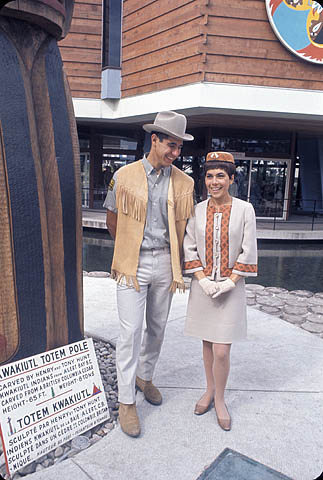|
New Sense of Unity Indians Migrating To Expo Pavilion By Rosemary Speirs, the Canadian Press MONTRÉAL (CP) -- Micmacs, Montagnais, Swampy Cree, Blackfoot and Haida.... Canada's Indians are travelling to Expo from all points of the compass this summer to find a new sense of unity and mutual understanding at their popular, teepee-shaped pavilion. "The only knowledge my people once had of other tribes such as the Sioux, they got from white men's magazine," Chief Andrew Deslisle of the 5,000-member Caughnawaga Iroquois band near Montréal said Tuesday. Those magazines made us believe the Sioux were bad people. Now we get to meet them here and we can see they're not. As commissioner-general of the controversial pavilion, soft-spoken Chief Deslisle has made his comfortable pavilion office an informal meeting place for Indians from British Columbia to Prince Edward Island. |
|
|
TRIBE CHANTS DANCE Tuesday his office was jammed by a friendly troupe of Blackfoot entertainers from Cluny, Alta, making their first trip ever to the East to dance and chant at Indian Day celebrations, scheduled for Friday afternoon in Place des Nations. They staged a drum-thumping war song on the sunny pavement outside the pavilion, which represents Plains' Indians with its large teepee; the West Coast with a totem pole carved for Expo by Kwakiutl craftsmen; and the East with birchbark canoes resting on a quiet pond. For two years before Expo opened, Chief Deslisle traveled to tribes across Canada asking Indian people what they wanted their pavilion to look like and to say. The result is a hard-hitting demand for Indian control of Indian affairs that Chief Deslisle figures makes Indian visitors feel "they are at last saying something of what they feel." FIRST INDIAN SURVEY "I doubt any Indian had ever before gone across Canada like that, finding out what other Indians were all about. White investigators have done it before, but never an Indian." |
 Indian host and hostess Photo credit: © National Archives of Canada |
|
Staffed by 14 pretty hostesses from tribes across Canada, the pavilion was built and is managed entirely by Indians. An advisory board of eight Indian leaders, including Chief Max Gros - Louis of Québec's Huron Indians, meets to settle tough problems with Chief Deslisle and deputy commissioners Russell Moses and T.R. Kelly. Lately Mr. Kelly, a Haida from British Columbia, and Mr. Moses, a Deleware from the Six Nations reserve near Brantford, Ont., have found that, like Chief Deslisle, they are being increasingly called on to explain the Indian point of view. "I wouldn't call us spokesmen for Canada's Indians," Mr. Moses says. "But Mr. Deslisle at least, has come to represent what this pavilion is asking for." - End of article. Copyright by the Canadian Press, August 9, 1967. All rights reserved.
|
|
